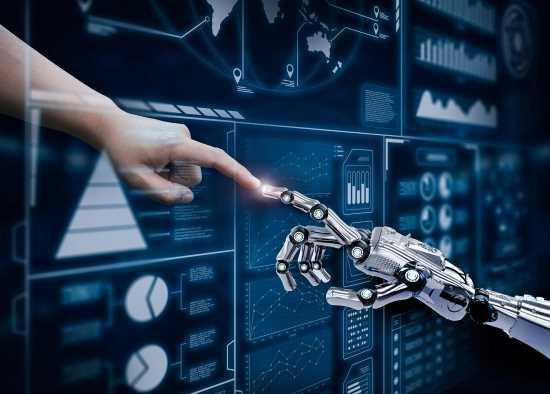The Rise of Augmented Intelligence
Artificial intelligence (AI) has increasingly become a hot topic of conversation, no doubt as a result of our fascination with the technology. And even though the potential benefits to the human race seem limitless, there are those who caution against widespread adoption of the technology. AI, after all, is often linked to the understandable concern that it threatens to reduce opportunities in the manufacturing sector for the human workforce.
Augmented intelligence (IA), however, may help to lessen these concerns. Whereas AI may be used to replace workers, IA is designed for use alongside human workers, enhancing their skills and improving their productivity and efficiency.

The Difference Between Augmented & Artificial Intelligence
There’s no arguing that AI has reduced the number of skilled workers required to complete a task or operate an assembly line. In plants across the globe, robotics and artificial technology are being used with increasing frequency to complete more strenuous and dangerous tasks. This rapid adoption has left many with a negative impression of the technology, and perhaps a questionable understanding of what it stands to offer businesses and consumers.
Augmented intelligence is actually part of what we define as artificial intelligence. However, this subset of the technology is setting itself apart in terms of delivering a considerable return on investment for businesses, while mitigating the negative impact on the established workforce.
Naturally, there is still considerable value in having human operators (AI still cannot compete with a human’s ability to adapt to unexpected situations); the goal of IA technology is to provide the insight and feedback necessary to enhance the operator’s decision-making abilities in those situations. The more information the operator has, the greater the likelihood that the actions taken will result in the desired outcome when things go wrong, and will foster a greater level of productivity when things are operating as they should. Of course, the workforce will need to possess a higher level of education when working alongside this technology, so being well versed in robotics training or PLC programming will undoubtedly set them apart from the rest, but that is to be expected as the technology becomes increasingly sophisticated.
So how does augmented intelligence work, exactly? Look at it this way. Humans possess very specific and very robust skill sets - but we aren’t the best at crunching large amounts of data and extracting crucial information in a timely manner. That’s where IA comes in. Most businesses have the ability to gather data, but lack the means to extract and apply the data in a meaningful way. Augmented intelligence can employ an algorithm that can create a predictive insight that is driven by concrete data. This, in turn, means that functions and processes can be redesigned for efficiency, and allows new opportunities to be uncovered. Best of all, applying AI doesn’t necessarily require vaste expenditures in new equipment or infrastructure.
IA & the Future of Work
Human workers have shortcomings; we have a tendency to tire as the day progresses, we can become distracted when completing repetitive tasks, and at times our actions can be governed by a lack of objectivity. These limitations can undoubtedly make a hard job harder. The implementation of IA can reduce some of this pressure, and help employees perform at a consistent level despite their shortcomings.
There are many applications of IA within manufacturing, the first of which is synchronizing diverse manufacturing systems, which is critical to breaking down the data silos that typically hold manufacturers back from greater efficiencies and cost savings. Second, IA allows manufacturers to use real-time data in combination with advanced analytics to gain the timely insights needed to achieve more significant cost optimization, higher quality, production improvements, and optimize maintenance, repair and operations (MRO) strategies. IA allows manufacturers to adopt machine learning within predictive analytics applications across shop floors, replace brute-force manufacturing execution system (MES) production scheduling, and generally optimize production workflows.
Outside of manufacturing, IA can also be used to make other, everyday tasks more efficient. Take conference calls for example; imagine being notified if you’re derailing a conversation with a topic that was already covered and resolved, or if you’re opening up a topic that is not on the established meeting agenda. The applications really are limitless and are not relegated to the factory floor or to the conference room. IA can be applied in just about every workplace to boost efficiency without necessarily reducing the size of the workforce.
The Broader Applications of IA
If we truly want to see IA widely accepted, those responsible for designing the applications need to emphasize the collaborative nature of the technology. Software engineers will need to do the heavy lifting to create the algorithms responsible for processing the data and delivering insights, but they’ll have to work closely with behavioural scientists and those with a background in human/computer interaction to make the technology accessible and meaningful enough for businesses and individuals to want to use it.
In order to appreciate the broader applications of IA, we need to view the technology as one that enhances and empowers us to get the most out of the very characteristics that make us human. Yes, there is value in applying IA technology in a business, but there is equal value in developing the technology to enhance our personal lives.
Augmented intelligence is one of the few technologies named on the 2019 Gartner Hype Cycle for Emerging Technologies that are predicted to reach expectations over the next two to five years. By emphasising collaborations between technology and human workers, the product of the work is more consistent, and the work itself is more efficient and enjoyable by the employee. It’s not about replacing the human worker, but rather helping them achieve their potential.
